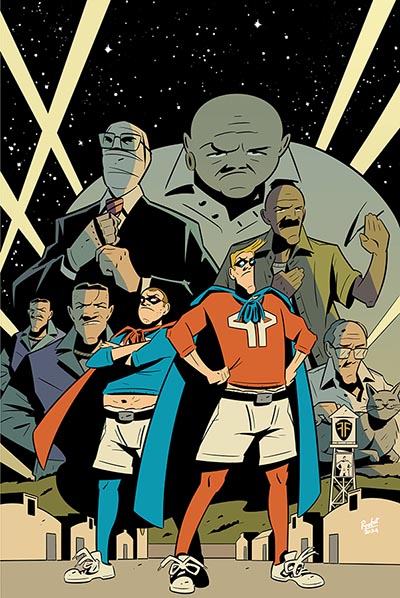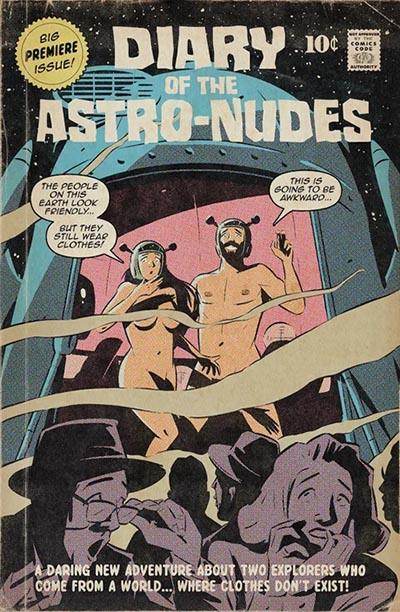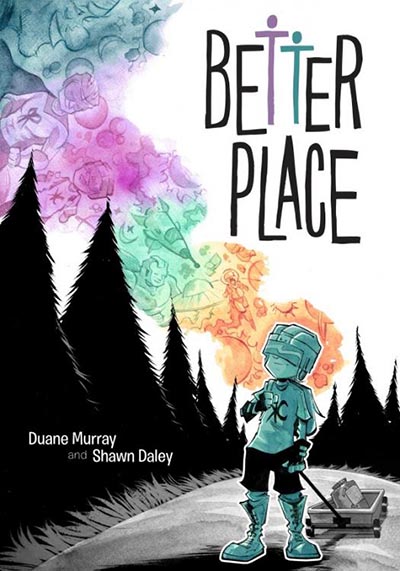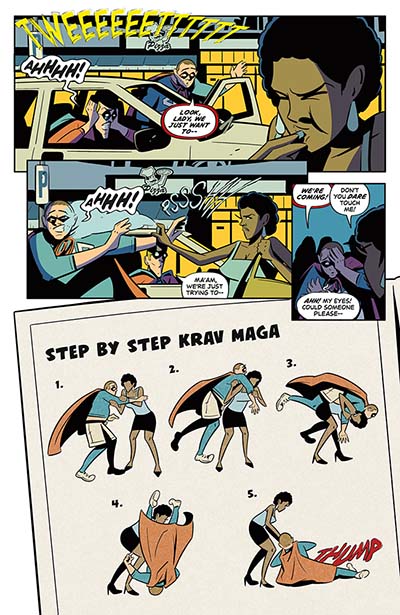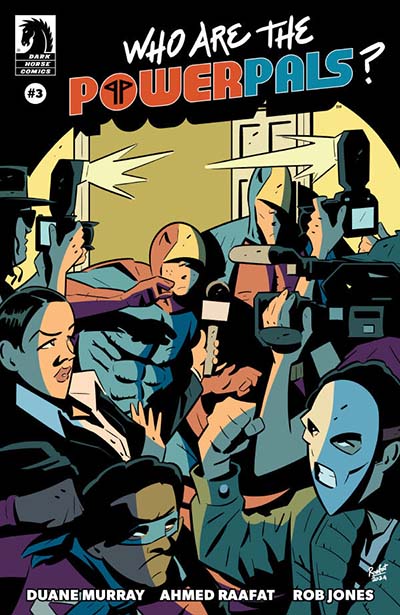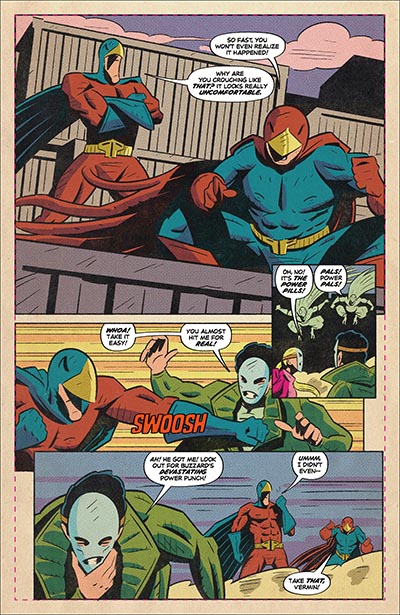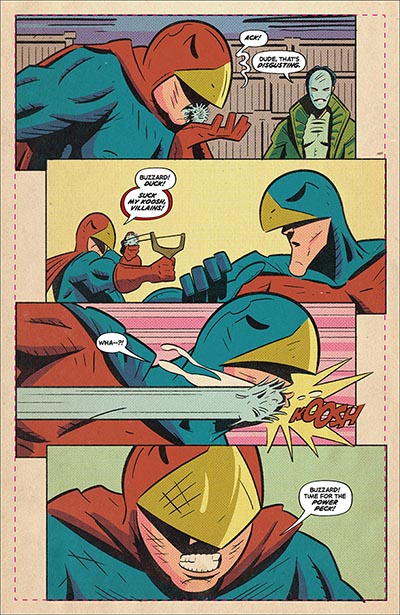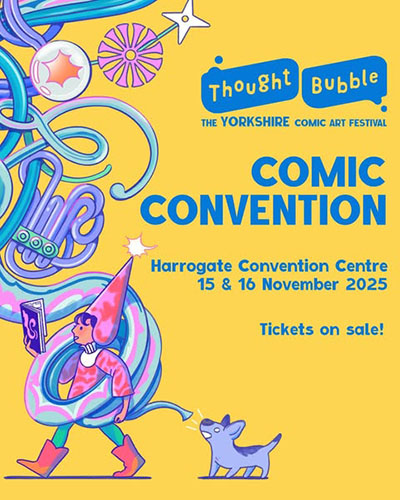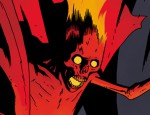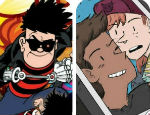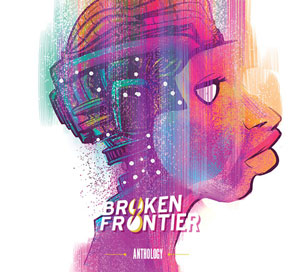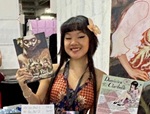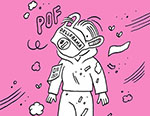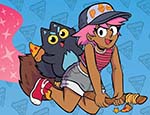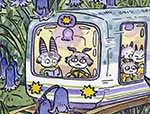THOUGHT BUBBLE MONTH 2025! A bumper interview offering today as part of our Thought Bubble coverage as we chat with Duane Murray and Ahmed Raafat, the writer and artist behind the recent acclaimed Dark Horse miniseries Who Are the Power Pals?. The story follows the exploits of two washed-up actors who in their teens played characters in a short-lived super-hero TV show, and what happens when in middle-age they accidentally become low-level real life crimefighters when their attempts to recapture their fame go awry. The trade paperback collection will be out in time for Thought Bubble.
Duane and Ahmed talk to us today about such varied topics as the comics scene in Egypt, the realities of the world of Hollywood, and working in Kevin Smith’s View Askewniverse. As well, of course, about Who Are the Power Pals?…
ANDY OLIVER: Ahmed, as an Egyptian cartoonist living in the UK the obvious opening question would be to ask you about the comics scene in Egypt and the kind of work that takes prominence there?
AHMED RAAFAT Growing up in Egypt and living most of my life there until moving to the UK ten years ago, comics have always been a component of Egyptian society but in a very different way to how they are in the UK. For instance, one of the longest running and most popular publications in Egypt is Mickey, which is a comic magazine featuring Disney characters (similar to the French Picsou) and has been published continuously since 1959. Over the decades, there have been comic magazines featuring original characters and original stories such as Samir, Aladdin and Flash (the first two occasionally also featuring translated stories from around the world), as well as other magazines from the Gulf such as Majid and Bassem which routinely featured the works of Egyptian artists and were distributed in Egypt.
Mainstream American comics had some audience as well, there were translations of Superman and Batman Silver Age stories translated and published by Lebanese publishing houses. With the 90s comics boom, there have also been several other attempts to license and translate American comics for an Arab market. One of my entry points into comics were the translations of The Batman Adventures, the comic series spun-off Batman: The Animated Series.
Political cartooning has also been a pillar of Egyptian comics for the longest time. While mostly reserved to newspapers, in recent years, there have been very successful attempts at longer narratives. One of the notable works is Magdy AlShafee’s Metro, published in 2008, which was critical of the government at the time and was banned until 2012. Tuktuk magazine was an anthology magazine featuring short stories with social/political themes, and more recently there have been many works aimed at a more mature audience.
Some American comics were also sold on newsstands, and you could occasionally find trades at bookshops. But the culture of dedicated comic shops, conventions, etc. had been missing from Egypt until very recently. Only in 2010 did we have the first comic shop – which lasted for only 6 years, and Cairo Comix Festival was the first comics festival in Egypt, starting in 2015. It has grown exponentially over the years, and now features a multitude of artists from Egypt and the Arab world.
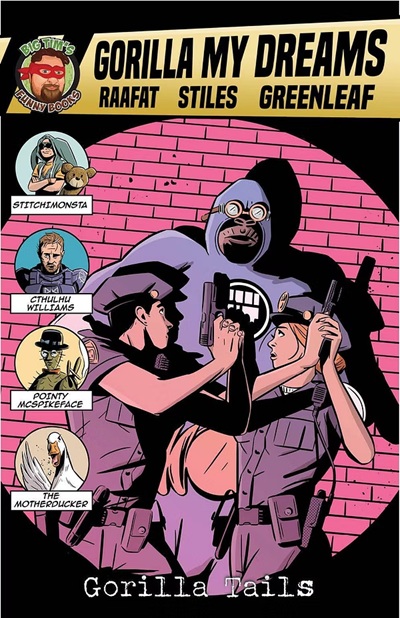
AO: Can you tell us a little about your self-published collaborative projects over the years like Gorilla My Dreams and Diary of the Astronudes? And what would be your one paragraph of advice for anyone starting on a self-publishing journey?
RAAFAT: Most of the work I have done throughout my career has been self-published work. El-Osba, my first comic book, which was published in Egypt, was self-published, and because crowdfunding isn’t as popular in Egypt as it is in the UK or US, it was all out of pocket. After publishing El-Osba in 2015, I moved to the UK, and started taking a career in comics more seriously, which was when I met Tim Stiles, the writer of Gorilla My Dreams, and we worked together on the series for years. All of the Gorilla My Dreams work was crowdfunded via Kickstarter, and I was involved running the campaigns although Tim did most of the heavy lifting.
Diary of the Astronudes was slightly different as it was my first solo project as writer/artist, and with that one I took care of all aspects of the crowdfunding. The comic started as a series of short stories I published online which I later put together in a print edition. I wanted to do something a bit different from superheroes and also wanted experiment with retro styles of colouring. I chose Zoop to crowdfund this one.
And to anyone thinking about starting their self-publishing journey my advice is always the same: do it! Nothing will teach how to make comics than making an actual comic. When I made my first comic, my goal wasn’t to have a career in comics or not even to make a perfect comic. I just wanted to prove to myself that I can do this thing, and to have my name on an actual published comic. That was it. I had no aspirations beyond that. And nothing beats that feeling of holding your own comic in your hand. And these days, it’s easier than ever to publish a comic. Pitching to a publisher is not the only route to get your work out there. Make a zine. Self-finance if you can. Crowdfund. Publish it online even! And it’s a messy process and you figure it along the way but you’ll get there in the end!
AO: How much of a thrill was it to become part of such a pop cultural phenomenon as Kevin Smith’s View Askewniverse in the pages of the Quick Stops comics?
RAAFAT: Honestly to this day I sometimes need to remind myself that this actually happened! I’ve been a fan of Kevin, both as a pop culture icon and a film director/writer for many years. When the first Quick Stops was announced, Kevin put a call on social media asking for artists to reply with samples from their work if they’d like to work on it. I sent my work because, what’s there to lose, and completely forgot that I did. Then a few months later I got a message from the editor asking if I’d like to draw an issue of Quick Stops. Of course yes! To this day, whenever I see on the online wikis that the first appearance of a character in the comics was drawn by me it still blows my mind. An absolute honour!
AO: Turning to you Duane, your debut graphic novel Better Place was published by Top Shelf a few years back. How did you go about adapting what was originally a screenplay to comics form? And what have been some of the more pleasing reader reactions to the themes of the story?
DUANE MURRAY: Since I had been a longtime screenwriter, I was luckily already pretty well versed in story structure and a visual storytelling format. That being said, comic scriptwriting is very different from screenwriting. The biggest difference to me being that there isn’t the same set of agreed upon ‘industry standard’ rules for comics writing the same way there is for screenplays, so you need to find what works best for you, and your collaborators.
I luckily had been a longtime comic reader, collector and fan, reading just about everything I could get my hands on, which included the old school comic writing books like Mark Salisbury’s Writers on Comics Scriptwriting, and Greg Rucka’s old Queen and Country scriptbook. These gave me a nice cross section of how the best do it. And I had also indirectly worked in comics through developing some of them for screen adaptations, which gave me access to a lot of comic scripts, and great comic writers minds.
From there… I approached writing Better Place in the way that worked best for me. Which is likely part screenplay writing, but also part ‘directors notes’, while also not going full Alan Moore and describing every little detail. Only putting that in where I felt necessary. And then… it was a matter of, as I started seeing how Shawn Daley reacted to the scripts I was writing and pages he was sending, slightly adjusting my writing toward him specifically. In comics, for me anyway, it’s more about developing a common dialogue between writer and artist than just telling the artist what to draw. I like to think I find a balance between being specific in places where I feel I need to be, and general enough in others so that the artist has room to do their thing.
Because in the end, comics is truly a collaboration, and at its strongest when that is a two way street. I approached Power Pals the same way with Ahmed. Specific where I feel it’s needed, and more general when not. And I often start everything with the note of, “This is how I see it, but happy to have you do your thing.” 99% of the time, if I am given art pages that differ from how I wrote them, I will adjust the dialogue to suit the visual rather than vice versa. The only time I will ask for something to be redrawn, is if I think the visual doesn’t make sense for the story.
Better Place art by Shawn Daley
I should also add, that the story for Better Place, though sharing some similarities to the screenplay, is very different. Especially since the screenplay never reached a ‘final’ version. It was always in some sort of early draft across the wildly different versions of the story. It’s not a matter of handing over a screenplay to an artist and saying, “here, make this a comic”. I wish more screenplay writers trying to get into comics understood that. It’s a whole different language and format, and it took me a year to write the comic script, which still underwent even more changes as Shawn started drawing.
As for the reader reactions, I have to say I am, and was a bit overwhelmed, and it was beyond my wildest expectations. Don’t get me wrong, like with all things comics, there are some bad comments and reviews out there, but way more positive ones. Most focus on the book itself, and the story, and characters, and art, and all the technical things that go into making a comic. But the ones that hit hardest, are the people who were hit emotionally by what it was about. Many of whom told me how it helped them deal with a loved one’s death. I never intended the book to be that, but the fact that it became that for some people is something I take very seriously, and am honoured by, and will keep close to me when I try to tackle issues in my stories that can be deeply emotional for some. It’s a big responsibility I didn’t even consider with Better Place, and I feel like I got lucky that I didn’t screw it up.
AO: How would you both describe the premise of Who Are the Power Pals? which will be collected by Dark Horse in time for Thought Bubble? And, Ahmed, how much fun was it flexing your artistic muscles on such a pop culturally nostalgic narrative?
MURRAY: The premise for Who Are The Power Pals? is about two washed-up middle-aged actors who experienced 30 seconds of fame playing teen superheroes in a quickly cancelled 90s tv show, who decide they want to reclaim that brief attention by putting on their old costumes and fighting low level crime, only to cross a Hollywood studio boss and international arms dealer who now wants them dead. I often call it a cross between the movie Pineapple Express (Seth Rogen should definitely option this) and Quantum and Woody. It’s wild, wacky, but hopefully with a little heart to ground it.
The tag is it’s about Fame, Friendship, and just how long you’re willing to fake it to make it.
RAAFAT: Who Are The Power Pals? is about two washed-up actors, Derek and Alex, who in the ’90s starred in a superhero TV show called Power Pals that was abruptly canceled after three episodes, and have been trying to jumpstart their careers again since then. After being fired from their studio security jobs and dropped by their agent, they decide to don their old costumes, and go to Hollywood Boulevard to try and make some money by taking photographs from tourists. But when Alex stops a pair of cosplayers badgering tourists and the incident goes viral, it thrusts them back into the limelight, but in new ways. Are they in it for the fame, or to fight crime? And it doesn’t help that a crazy crime boss is also now on their tail! If you’re a fan of buddy comedies, 90s low budget superhero shows (and the 90s in general), then this book is for you!
And I am very proud of playing with format that we have done in this book! This book isn’t just an homage to our love for the 90s, but to our love for comics and comic art in general. We did throwbacks to Sunday strips, we did throwbacks to 90s Image comics (a particular artist – IYKYK), we did throwbacks to Dark Knight Returns with the television segments, we did abstract, pop art style pages… Duane knows my work quite well and knows where my strengths are but also knows how to push me just a little bit beyond my comfort zone. Every time there was an unconventional page he’d ask me if I was OK with doing this and my answer is always: I am always up for a challenge!
AO: Ahmed, your art has such an appealingly expressive quality to it, particularly in your character work. Who do you count among your inspirations, and can you tell us about your creative process and the mediums you work in?
RAFAAT: Oooh, that’s always a tough question! I guess I lean more into artists with an art style that’s heavy on shading/negative space, and also a stripped down figure work. So Toth, early Mazzucchelli, Mignola, Cooke, David Aja, Francavilla, Jock, all the way to Chris Samnee and Tyler Boss to name a few! But it also largely depends on the project. Before I start a project, I like to look at works with similar style I have in mind to get inspiration. For Quick Stops for instance, I was looking at the earlier Clerks comics by Jim Mahfood and Phil Hester, specifically since both have a cartoony style and were dealing with likenesses and I wanted to see how they approached that. With Astronudes, I was looking at old Archie comics, and also EC comics to get a grasp on the colouring. For Power Pals, I was looking at contemporary “fun” superhero comics such as Who Killed Jimmy Olsen. And 4 Kids Walk Into a Bank was an inspiration for Duane when writing and there are some pages in Power Pals that are trying to emulate the same vibe of the book.
As for process/medium, I’ve been working digitally most of my career. I started only inking digitally then decided it would be faster to do it all digital. In terms of process, my approach is usually the same – start with rough layouts (or thumbnails), then digital pencils, then inks and colours.
AO: Duane, much is the story informed by your own experiences of working in the film and TV industry?
MURRAY: A lot. I don’t want to get into some of the details, but I’ve been very privy to some very insider type things in ‘Hollywood’ over the years due to my involvement in various things. As an actor. Script doctor. Acting coach. I’ve worked on some very big things that no one will ever really know, because I’m a lifelong, low rung player. I’ve also been in Alex and Derek’s shoes in that I’ve come very close to some very big things that would have been life-altering, that never happened, so instead I’m scraping by trying to write comics, which I love, so it’s not all bad.
It is also informed by my friendship to my best friend, who I was originally batting this idea around with, and who I used to collaborate with all the time on various film and TV projects. We now work separately on our own things, but do plan on doing stuff together again. But that friendship and how we approached projects is definitely reflected at last a little in Alex and Derek’s relationship.
AO: You have the work of 2024 Broken Frontier Award Winner (Best Letterer) Rob Jones on the project. Obviously we’re huge fans of Rob’s work here at BF so what qualities did his contributions bring to the book?
RAFAAT: Rob was one of the first people I got to know when I moved to the UK and started to get more familiar with the UK comic scene. We’ve been friends and worked together before on countless projects, with Rob either writer or letterer (or sometimes both!), so when Duane asked me for letterer recommendations I went to him with Rob and also Andrew Thomas who’s been letterer on my Quick Stops work and most Kevin Smith projects. Duane chose Rob in the end and it was great having him as part of the team! And it was much more than just sending pages to have them lettered, it was a collaborative effort from the pencils stage, especially with the more design heavy pages like the retro throwbacks.
MURRAY: For me, working with Rob started with Ahmed. Ahmed and I connected through Twitter, after someone Ahmed knows tagged him in a post creator Michael Walsh made for me looking for an artist. I saw Ahmed’s online stuff, and his Astronudes strip, and immediately reached out. In the pitch, Ahmed did his own lettering, which was quite fine as Ahmed has a great general desk sense, but I knew the lettering would be incredibly important on this. Pretty much like a character unto itself, and so I wanted someone whose sole focus would be that, while also freeing up time for Ahmed to solely focus on art.
Since I had never worked with a letterer (Shawn Daley lettered himself on Better Place) I wanted to work with someone Ahmed had worked with before so he would have an existing relationship and language. I was looking strongly at Andrew Thomas, since he had lettered Ahmed on Quick Stops AND lives in the GTHA (Greater Toronto Hamilton Area) here in Canada where I live. Rob had also worked with Ahmed on some anthology stuff I believe, and so I looked at his other work, and it won me over. Because beyond being solid, he took big swings. I’m someone who likes SFX and to mess around with different styles and weirdness, and Rob’s work had that. I threw a lot at him. Like little character designs for narration boxes, and challenging panel layouts for Ahmed that Rob would need to somehow make work, and he delivered above and beyond. His name is on the front of the book for a reason. as much a collaborator as Ahmed and I, and I hope they both get recognized for the incredible work they did on this. I think it’s unlike anything else with a major publisher out there.
AO: Do you have any plans to return to this world and its characters in the future?
MURRAY: I honestly don’t know. I don’t know if there is demand for it. I would. After Ahmed sent me the special limited bookplate he created for the Thought Bubble trade release, it put a big smile on my face, because I love those characters and I already missed them. I can say I have a general storyline in my head, and the very last page of the story in the first trade is left open, and alludes to that story, but no immediate plans yet to actually do it.
RAAFAT: As Duane said, there are no immediate plans but if there was an opportunity to continue the story of these two characters I would definitely jump on it! When you spend a year (or in Power Pals’ case – 3 years since the pitch) drawing characters on a daily basis they kind of like become your friends, and it’s always bittersweet when you draw that last page – sweet as in the work is now complete and it’ll soon be out to the world to enjoy, but bitter because this could be the last time you get to spend time with those characters. And as Duane mentioned, the last page is a tease for what could potentially come next, so there’s room for many more stories. I have a wish list for things I’d like to see/draw in a second part, ready to hit send to Duane whenever we get the call!
AO: Ahmed, your work was exhibited at the Young V&A Museum this year. Comics artists often struggle to get that kind of recognition by arts institutions so how did it feel to see your art in such prestigious surroundings?
RAAFAT: A moment of pride definitely. And I’m glad Young V&A were keen to highlight Egyptian superhero stories made by Egyptian creators alongside the ones made by non-Egyptian ones, and put the main focus on them.
AO: What next for you both? What can we look forward to from you in 2026?
MURRAY: In terms of comics, I am currently working on another OGN with artist Scott Brian Woods. It is scheduled to be published late 2026/early 2027, which I am excited about. I also have a pitch I am working on for another book with Shawn Daley since everyone always asks us when our next book will be out. And then long term I have a thing brewing with artist Kalman Andrasofszky. Other than that the mind is always racing with what else I can do, and my emails are open for when DC wants to give Ahmed and I an Aztek the Ultimate Man series to do.
RAAFAT: I have an issue in Quick Stops Vol. 3 that comes out in November, this time focusing on the Jones sisters (Heather Jones from Clerks, Tricia Jones from Mallrats and Alyssa Jones from Chasing Amy). Always fun to work on a story that serves as connective tissue between different Smith films, and I think it might be the first comic book appearance for one or two characters. Other than that, I’ve been pitching a few projects for the last few months, and waiting to see if/where they land!
Interview by Andy Oliver
Ahmed Raafat and Duane Murray will be at Table F11 in the 2000 AD Hall at Thought Bubble.
Thought Bubble 2025 runs from November 1oth-16th with the convention weekend taking place on the 15th-16th. More details on the Thought Bubble site here.
Read all our Thought Bubble 2025 coverage so far in one place here.
Poster by Ng Yin Shian






